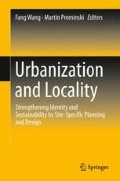Abstract
In the 1980s, Professor Fei Xiaotong discussed three topics in small town research in his 1985 book “Four Texts of Small Towns,” namely, rural industrialization, urbanization of population, and economic marketization.
Access this chapter
Tax calculation will be finalised at checkout
Purchases are for personal use only
Notes
- 1.
According to the National Bureau of Statistics of the People’s Republic of China (http://data.stats.gov.cn).
- 2.
At present, China has two sets of land management systems for the city and the countryside, which are independent of each other. If rural land needs to be urbanized, it must go through land requisition formalities. Only the government has the right to land requisition. In the land increment income from the requisition, peasants’ compensation only accounts for 5–10 %. Peasants could neither get due land increment income by their land nor buy houses and receive public services as urban residents (urban households) do in cities because they are registered to hold agricultural permanent residence (rural household).
- 3.
“Half urbanization” refers to the scenario where a peasant-worker living in a city is counted in the urbanization rate but lacks the same rights and welfare as urban residents (for not owning an urban household).
- 4.
The CPC has consecutively issued 5 No. 1 Documents on the theme of countryside, agriculture, and farmers from 1982 to 1982, deploying rural reform and agricultural development. From 2004 to 2014, the CPC consecutively issued the “Three Agriculture” themed No. 1 Documents to emphasize the most important status of the “Three Agriculture” issue in the period of China’s socialist modernization. According to the website of the Central People’s Government of the People’s Republic of China (http://www.gov.cn/).
- 5.
According to the “Decision of the CCCPC on Major Issues Concerning Comprehensively Deepening the Reform” adopted at the Third Plenary Session of the 18th Central Committee of the Communist Party of China on November 12, 2013.
- 6.
According to the “Urban and Rural Planning Law of the People’s Republic of China” published by the China Legal Publishing House in 2007.
- 7.
According to the “National New Urbanization Planning (2014–2020)” published by People’s Publishing House in 2014.
- 8.
According to the website of the Ministry of Science and Technology of the People’s Republic of China (http://www.most.gov.cn).
- 9.
According to the “Standard for planning of towns (GB50188-2007)” promulgated by the Ministry of Construction of the People’s Republic of China in 2007.
- 10.
According to the “Technique code for village rehabilitation (GB50445-2008)” promulgated by the Ministry of Housing and Urban–Rural Development of the People’s Republic of China in 2008.
- 11.
According to the website of the Ministry of Science and Technology of the People’s Republic of China (http://www.most.gov.cn).
- 12.
Quoting Prof. Li Jing’s explanation: Agriculture’s third industrialization is an extension of agriculture’s own service function and enlargement of agriculture’s external scale, in order to give full play to the multi-functionality of agriculture.
References
Bai JM (2008) Study on the theory and application patterns for circular agriculture in China. Dissertation for Doctorate. Chinese Academy of Agricultural Sciences, Beijing, p 8. (in Chinese)
Cheng YK, Cheng CY (2009) Discussions of the balance between experimental zone of urban-rural and development of city sightseeing agricultural: the 11th annual meeting of China association for science and technology, session 26 urban modern agriculture seminar. Chinese Agric Sci Bull 100–102. (in Chinese)
Fei XT (1985) Four texts of small towns. Xinhua Press, Beijing (in Chinese)
Hao ZJ, Chen LP et al (2004) A study about development of ecotype urban agriculture in Chongqing. Res Agric Modernization 1:64–67. (in Chinese)
Li H, Xia XL (2008) Strategic thinking for the development of small towns in the context of urban-rural integration. China Collective Econ 5:13–14 (in Chinese)
Li JS, Zhou LY (2013) Suburban agriculture’s transformation into tertiary sector and its urban planning in the perspective of new urbanization: the example of Xiaowangmiao District of Fenghua. Time Archit 6:42–47 (in Chinese)
Lin XL, Zhou YH (2012) An empirical analysis on the eco-environmental effect of circulatory agriculture mode of planting-breeding in the paddy field—taking the paddy-fish mode in the southern paddy area as an example. China Popul Res Environ 3:37–42. (in Chinese)
Qian ZH, He B (2009) An analysis on the planning mode of urban-rural integrated in the eastern and western regions. Urban Dev Stud 3. (in Chinese)
Tang J (2010) An empirical analysis on the agricultural industrialization management and land consolidation in the hilly areas of Central Sichuan: taking the example of the modern planting base for the Chinese Medicine of Sichuan Hui Chun Tang Pharmaceutical Company. Econ Aff 5:62–67. (in Chinese)
Zhang SW (2014) Rural planning: characteristics and difficulties. City Planning Rev 2:17–21. (in Chinese)
Zheng FT, Pu MZ (2014) New urbanization: institution shackles and solution paths. People’s Tribune Frontiers 6:62–71 (in Chinese)
Zhou FY, Lu FJ, Zhang YL (2005) Problems and counter measures in the development of the Chinese medicine planting. J Agrotechn Econ 2:76–79. (in Chinese
Zhu LT (2014) Study of fiscal policy on promoting the adjustment of Chinese economic structure. Dissertation for Doctorate. Research Institute for Fiscal Science, Ministry of Finance, Beijing, P.R.China. (in Chinese)
Acknowledgment
This article is supported by the National Science & Technology Pillar Program during the 12th Five-year Plan Period: the Synthesis Technology Integration and Demonstration for the Construction of Suburban “Beautiful Villages” within the type of Industry extension and upgrade (Grant No. 2015BAL01B04).
Author information
Authors and Affiliations
Corresponding author
Editor information
Editors and Affiliations
Rights and permissions
Copyright information
© 2016 Springer Science+Business Media Singapore
About this chapter
Cite this chapter
Long, H., Li, J., Lu, F., Chu, D. (2016). Mountainous Rural Urbanization: Space Integration of Industry and Village. In: Wang, F., Prominski, M. (eds) Urbanization and Locality. Springer, Berlin, Heidelberg. https://doi.org/10.1007/978-3-662-48494-4_5
Download citation
DOI: https://doi.org/10.1007/978-3-662-48494-4_5
Published:
Publisher Name: Springer, Berlin, Heidelberg
Print ISBN: 978-3-662-48492-0
Online ISBN: 978-3-662-48494-4
eBook Packages: Economics and FinanceEconomics and Finance (R0)

